Compared: HomePod mini versus HomePod
During Tuesday's event, Apple launched the HomePod mini, a compact spin-off of the HomePod that costs just $99, but is it worth getting instead of the full-size original? Here's the tale of the specifications.
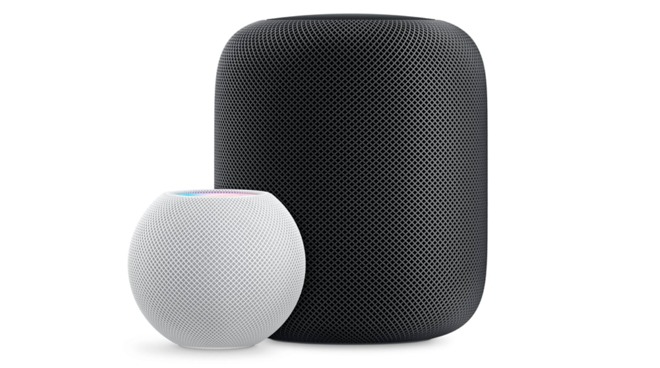
The HomePod mini (left) and the HomePod
The HomePod mini is a smaller HomePod. Shrinking down both the size and the price of the speaker down to something comparable to portable Bluetooth speakers already on the market, the HomePod mini aims to differentiate itself in the same way as the HomePod, namely with enhanced integration with your iPhone and other Apple devices.
The cut in cost and in physical stature introduces some other changes borne from limitations, something that may make potential HomePod buyers stop for a second and consider before their purchase. Sure, there's an expectation of quality reduction given the price, but by how much?
While we all have to wait until the release of the HomePod mini to make a direct comparison in audio quality against its full-size stablemate, there are still quite a few areas worth comparing between the two models ahead of that time.
The size difference is further accentuated by a change in shape. The HomePod is cylindrical in shape, with rounded edges at the top and bottom to create two flat sides, complete with a display on the top.
The HomePod mini switches the cylinder for a sphere, with the ball-like appearance interrupted by two small flat edges, again at the top and bottom. Again, while the top is used for the display and main interface, the bottom flat section simply prevents it from rolling off a surface.
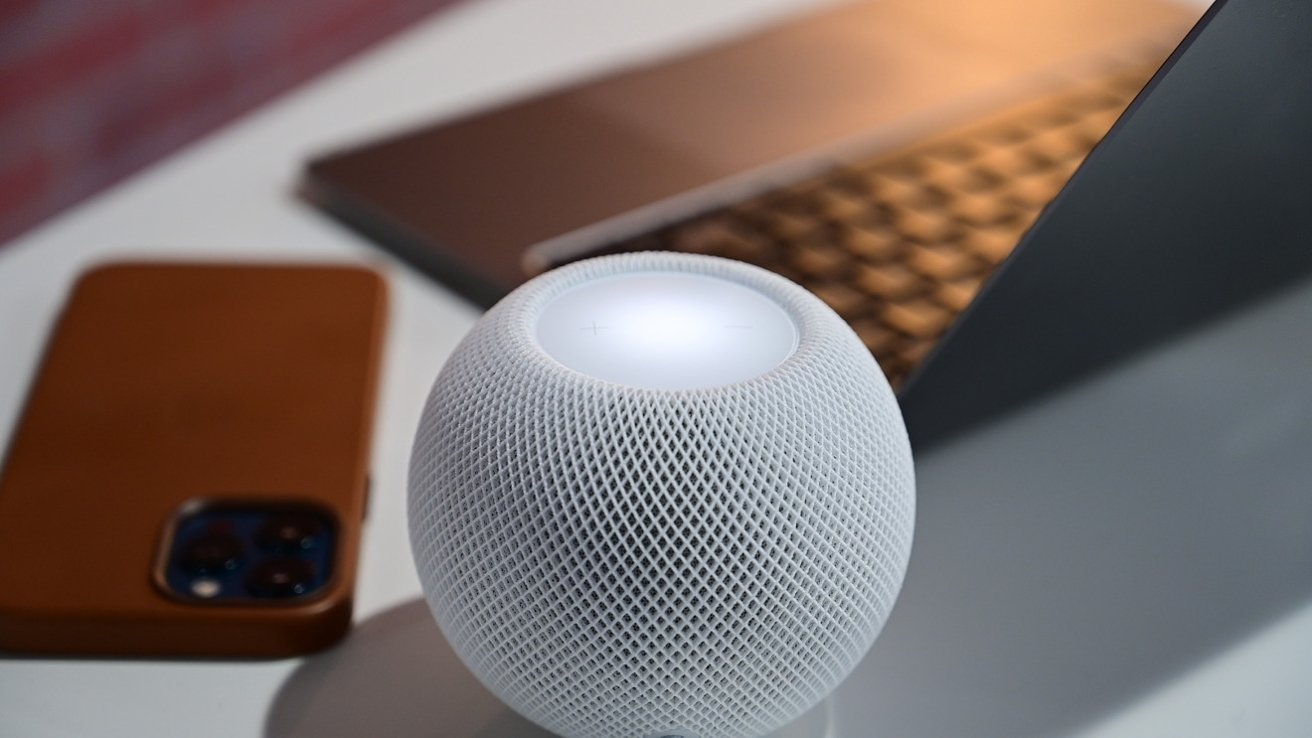
The HomePod mini is spherical, with two cutouts for the screen and to stop it rolling away.
As you would also naturally expect, the HomePod mini is considerably lighter, weighing in at 0.76 pounds (345 grams) against the 5.5 pound (2.5kg) HomePod. Though some of the weigh loss will simply be from needing less of a chassis, it is also probable that the alterations to the internals to fit the smaller frame also had an impact in the weight loss.
One thing that certainly hasn't changed is Apple's use of a seamless mesh fabric, which is designed to be both aesthetically pleasing and minimize its impact on sound waves passing through it.
The original HomePod boasts a high-excursion woofer at the top of the speaker for bass, along with a collection of seven beamforming tweeters at the base using a folded-horn design. Each speaker also had its own custom amplifier, and took advantage of on-device processing to perfect its sound output.
It doesn't take much to work out you can't fit all of the HomePod's speakers into a ball that size. Instead, Apple uses a single full-range driver with an "incredibly powerful neodymium magnet" to cover both deep bass sounds and crisp high frequencies.
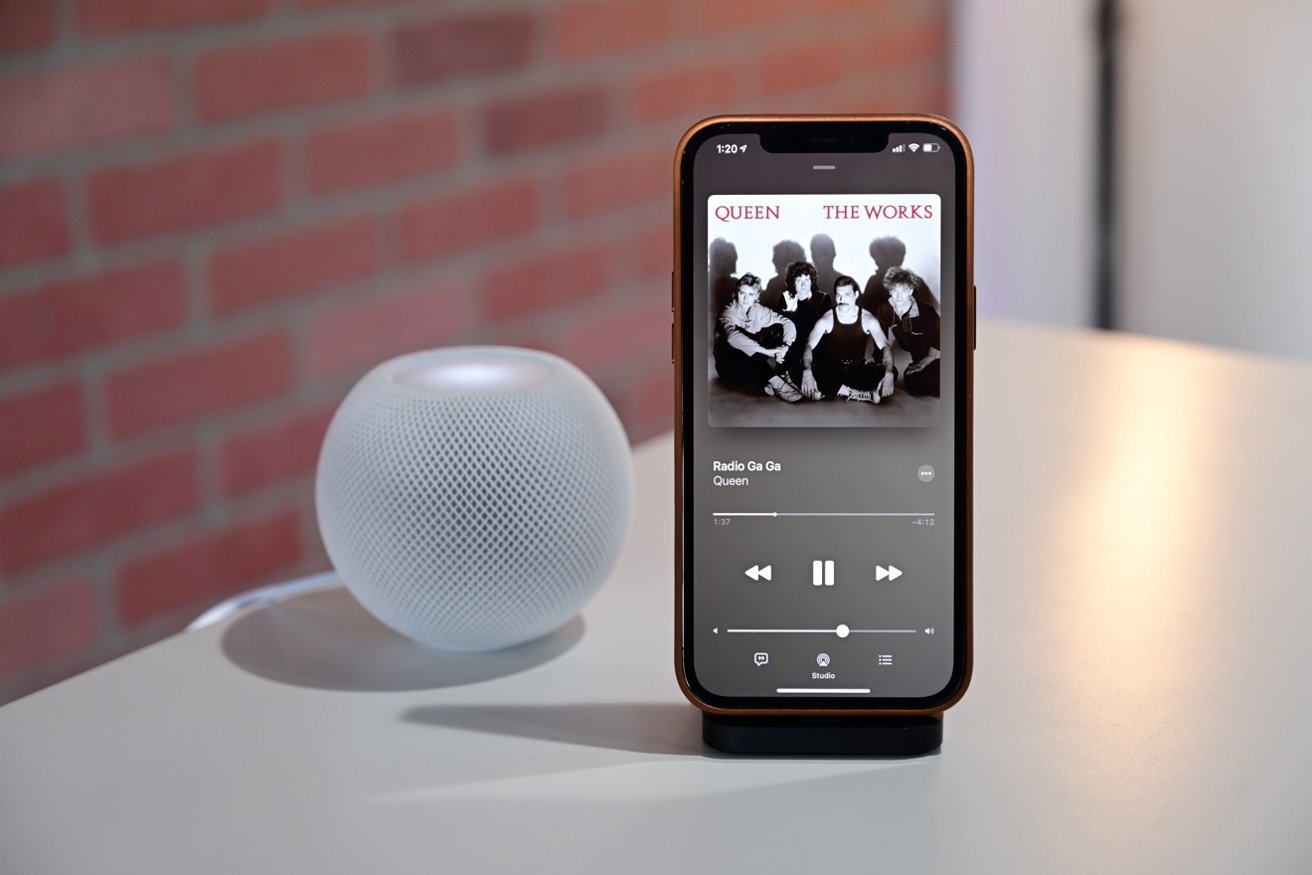
The center driving speaker of the HomePod mini points downward.
Switching from multiple separate speakers to one do-all version is likely to result in some deterioration of audio quality, but Apple claims its computational audio algorithms will help fine tune the sound to be balanced at all times. As smaller speakers usually have trouble with bass sounds, Apple has also included force-cancelling passive radiators to create a bass extension, assisting to create a fuller sound.
Apple also uses a trick in design to produce 360-degree audio from a single speaker, something that is performed by a larger number of speakers on the HomePod. For the HomePod mini, that full-range driver is pointed down at an acoustic waveguide, effectively cones at the base of the device that reflect and divert sound through the sides.
For the HomePod mini, the count is reduced down to four, which is fewer but not as severe as the speaker count. Three are pointing outward for coverage, while the fourth is inward-facing to isolate sound from the speaker itself, to help improve voice detection while music is being played via a form of noise cancellation.
While it may not be as many as the HomePod, the three externally-facing mics in the HomePod mini are enough to do the job with full coverage on all sides of the smart speaker.
Going for an S-series chip may also help cut the power consumption of the speaker down versus the A-series equivalent. Though given that both models still take power from an outlet, the savings are negligible.
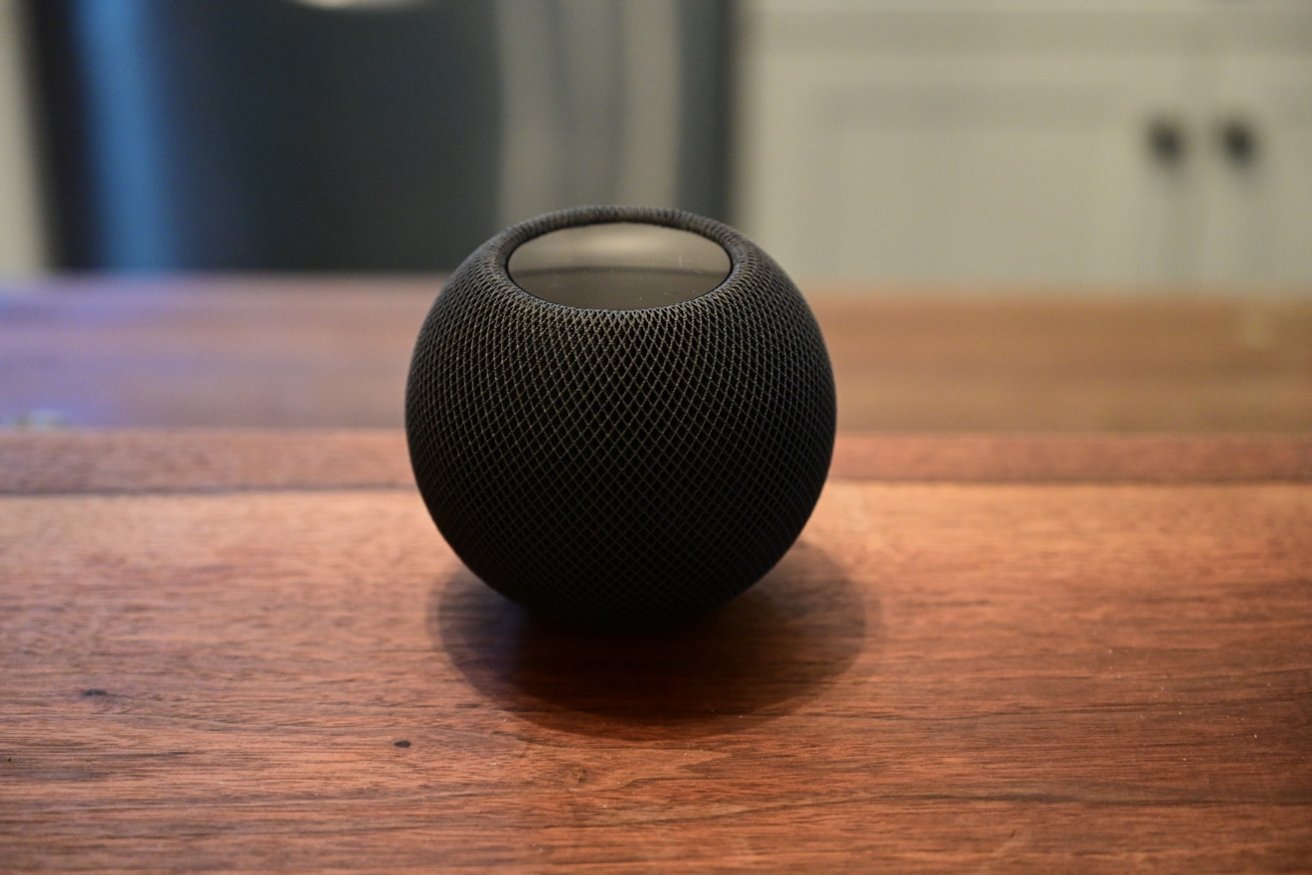
The HomePod mini retains a display, despite its small size.
In terms of what each speaker can do to the audio, Apple boasted that the HomePod's A8 had "real-time studio-level processing" to maximize bass while minimizing distortion, could upmix direct and ambient audio, has a faster-than-realtime buffer, and created room-filling sound.
The HomePod mini is also powerful, with it including "complex algorithms" processed in real-time for a "balanced, fine-tuned sound at any volume." This includes tuning models to optimize loudness, adjust the dynamic range, and even control the movement of the driver and radiators in real-time.
There's also a continuation of the multi-room audio capabilities driven by AirPlay 2.
As expected, Siri is also the main interface vector for the HomePod mini, with it taking the usual cavalcade of verbal requests and tasks that the HomePod can accomplish. Naturally, this feeds into HomeKit, with Siri able to manage scenes and control smart home accessories by command.
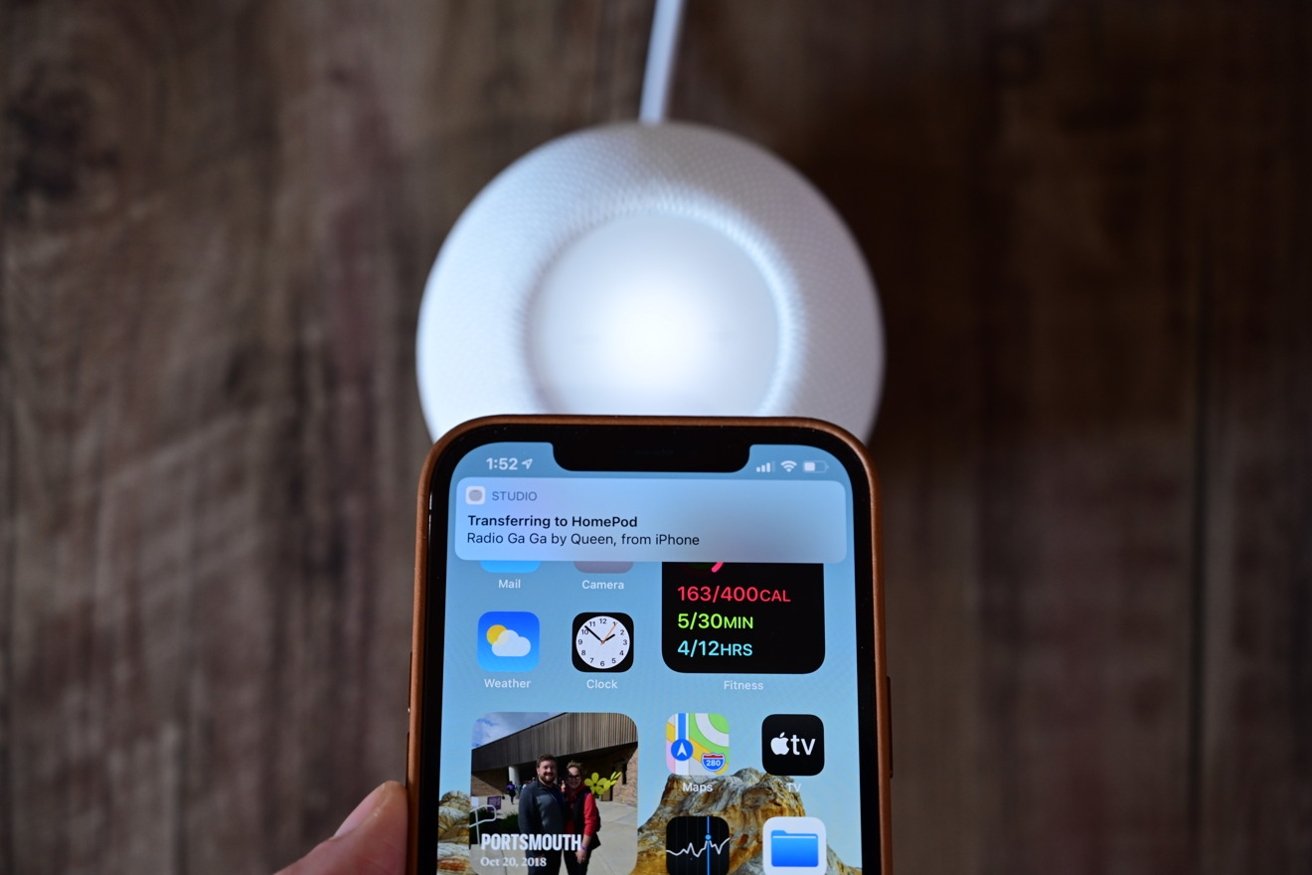
You can still hand off music by moving an iPhone nearby the HomePod mini.
New for 2020 is an Intercom feature, that allows family members to quickly send verbal notes to each other from a HomePod or HomePod mini to another in the house, as well as iPhones, iPads, the Apple Watch, AirPods, and CarPlay.
Multi-user support means individual playlists and person-specific commands are available via Siri, with the digital assistant learning the voice of each user to identify them.
You cannot use the HomePod mini as home theater speakers with the Apple TV 4K in this way. Where the HomePod has a dedicated woofer for impressive bass, you're just not going to get that with the full-range speaker in the HomePod mini.
You can, however, still use the HomePod mini to play stereo audio from an Apple TV.
On pure wireless networking, the HomePod is doing better with support for 802.11ac over the HomePod mini's 802.11n. It's arguable that there's not much need to go faster, as audio streaming doesn't need massive amounts of bandwidth, so this seems to be a relatively ok change in the HomePod mini.
Both models do connect over Bluetooth 5.0, and even support proximity-based handoff where the user moves their iPhone near to the speaker.
The HomePod mini does benefit from the addition of two technologies not found on the HomePod. Ultra Wideband will enable it to perform proximity-based activities much smoother with devices equipped with the U1 chip or otherwise support UWB, and could even be useful in AR and location tracking services in the future.
Interestingly, there's also support for Thread in the HomePod mini. Thread is a smart mesh networking standard that allows devices to connect to each other instead of directly to a hub, which can expand the range of communications for smart home appliances.
The inclusion of Thread support in the HomePod mini may signify Apple intends to use it as a smart home hub for other Thread-supporting hardware, though that does rely on its use in other devices.
The HomePod is priced at $299 per unit, with AppleCare+ an additional $39.
The HomePod mini costs $99 for the speaker, with AppleCare+ an additional $15. Pre-orders for the HomePod mini commence from November 6, with shipments starting November 16.

The HomePod mini is small, but packs a big audio punch.
The HomePod certainly benefits from its speakers and microphones against the considerably cut down numbers used in the HomePod mini. Though we won't know for certain until the HomePod mini reaches our hands and ears, it is highly likely the original will still be the better of the two models for audio quality.
That isn't to say that the HomePod mini will produce poor audio, as it still has Apple's engineering knowhow squeezing every last drop of quality it can from the limited size and components. Indeed, it's probably going to offer decent enough audio for most users, if not at the dizzying heights of the HomePod.
There's the argument that, if the HomePod mini's sound is good enough, you could get that and enjoy all that it offers for a third of the price of the HomePod. That would be a good assumption to make, but you can easily take it a stage further.
With such a relatively cheap price, there's nothing stopping someone from buying a pair of HomePod minis for stereo audio, and still save money instead of buying one HomePod. There's even the possibility of putting more HomePod minis throughout a home due to the low cost and small size, whereas doing the same with HomePods may be too cost prohibitive.
In short, in cases where audio quality is mandated, the HomePod will be the best choice. Need speakers to create home cinema sound? Get a pair of HomePods.
For everyone else, the HomePod mini will do the job, and then some.
Stay on top of all Apple news right from your HomePod or HomePod mini. Say, "Hey, Siri, play AppleInsider Daily," and you'll get a fast update direct from the AppleInsider team.

The HomePod mini (left) and the HomePod
The HomePod mini is a smaller HomePod. Shrinking down both the size and the price of the speaker down to something comparable to portable Bluetooth speakers already on the market, the HomePod mini aims to differentiate itself in the same way as the HomePod, namely with enhanced integration with your iPhone and other Apple devices.
The cut in cost and in physical stature introduces some other changes borne from limitations, something that may make potential HomePod buyers stop for a second and consider before their purchase. Sure, there's an expectation of quality reduction given the price, but by how much?
While we all have to wait until the release of the HomePod mini to make a direct comparison in audio quality against its full-size stablemate, there are still quite a few areas worth comparing between the two models ahead of that time.
Specifications
| HomePod Mini | HomePod | |
|---|---|---|
| Price | $99 | $299 |
| Dimensions (inches) | 3.3 x 3.9 | 6.8 x 5.6 |
| Weight (pounds) | 0.76 | 5.5 |
| Processor | S5 | A8 |
| Speakers | Full-range driver and dual passive radiators, Custom acoustic waveguide | High-excursion woofer with custom amplifier, 7 horn-loaded tweeters with custom amplifiers. |
| Microphone Array | 4 | 6 |
| Connectivity | 802.11n Wi-Fi Bluetooth 5.0 Thread Ultra Wideband | 802.11ac Wi-Fi Bluetooth 5.0 |
| Colors | White, Space Gray | White, Space Gray |
HomePod mini vs HomePod - Physical Design
As you would expect the name to suggest, the HomePod mini is small when put against the HomePod. While the HomePod is 6.8 inches tall and 5.6 inches wide, the HomePod mini is less than half the height at 3.3 inches, and thinner at 3.9 inches across.The size difference is further accentuated by a change in shape. The HomePod is cylindrical in shape, with rounded edges at the top and bottom to create two flat sides, complete with a display on the top.
The HomePod mini switches the cylinder for a sphere, with the ball-like appearance interrupted by two small flat edges, again at the top and bottom. Again, while the top is used for the display and main interface, the bottom flat section simply prevents it from rolling off a surface.

The HomePod mini is spherical, with two cutouts for the screen and to stop it rolling away.
As you would also naturally expect, the HomePod mini is considerably lighter, weighing in at 0.76 pounds (345 grams) against the 5.5 pound (2.5kg) HomePod. Though some of the weigh loss will simply be from needing less of a chassis, it is also probable that the alterations to the internals to fit the smaller frame also had an impact in the weight loss.
One thing that certainly hasn't changed is Apple's use of a seamless mesh fabric, which is designed to be both aesthetically pleasing and minimize its impact on sound waves passing through it.
HomePod mini vs HomePod - Speakers
One unavoidable change is the number of speakers included in the HomePod mini, and obviously there are fewer than in the HomePod.The original HomePod boasts a high-excursion woofer at the top of the speaker for bass, along with a collection of seven beamforming tweeters at the base using a folded-horn design. Each speaker also had its own custom amplifier, and took advantage of on-device processing to perfect its sound output.
It doesn't take much to work out you can't fit all of the HomePod's speakers into a ball that size. Instead, Apple uses a single full-range driver with an "incredibly powerful neodymium magnet" to cover both deep bass sounds and crisp high frequencies.

The center driving speaker of the HomePod mini points downward.
Switching from multiple separate speakers to one do-all version is likely to result in some deterioration of audio quality, but Apple claims its computational audio algorithms will help fine tune the sound to be balanced at all times. As smaller speakers usually have trouble with bass sounds, Apple has also included force-cancelling passive radiators to create a bass extension, assisting to create a fuller sound.
Apple also uses a trick in design to produce 360-degree audio from a single speaker, something that is performed by a larger number of speakers on the HomePod. For the HomePod mini, that full-range driver is pointed down at an acoustic waveguide, effectively cones at the base of the device that reflect and divert sound through the sides.
HomePod mini vs HomePod - Microphones
Another casualty in the weight-loss program are the microphones. The HomePod enlisted six microphones around the device, to pick up sound from around the room, with echo and noise cancellation processing used to enhance vocal pick-up for Siri commands.For the HomePod mini, the count is reduced down to four, which is fewer but not as severe as the speaker count. Three are pointing outward for coverage, while the fourth is inward-facing to isolate sound from the speaker itself, to help improve voice detection while music is being played via a form of noise cancellation.
While it may not be as many as the HomePod, the three externally-facing mics in the HomePod mini are enough to do the job with full coverage on all sides of the smart speaker.
HomePod mini vs HomePod - Audio Processing
For audio processing duties, the HomePod uses the A8, a chip previously employed for the iPhones, while the HomePod mini uses the newer S5 chip. This is actually the same chip used in the Apple Watch Series 5, so its ability to play and process audio, as well as handle Siri and other features, is already well established.Going for an S-series chip may also help cut the power consumption of the speaker down versus the A-series equivalent. Though given that both models still take power from an outlet, the savings are negligible.

The HomePod mini retains a display, despite its small size.
In terms of what each speaker can do to the audio, Apple boasted that the HomePod's A8 had "real-time studio-level processing" to maximize bass while minimizing distortion, could upmix direct and ambient audio, has a faster-than-realtime buffer, and created room-filling sound.
The HomePod mini is also powerful, with it including "complex algorithms" processed in real-time for a "balanced, fine-tuned sound at any volume." This includes tuning models to optimize loudness, adjust the dynamic range, and even control the movement of the driver and radiators in real-time.
HomePod mini vs HomePod - Functionality
Like the original, the HomePod mini is capable of being used as a stereo pair when used alongside another HomePod mini. Sadly you cannot use a HomePod and a HomePod mini as a stereo pair together, as you require two of the same speaker.There's also a continuation of the multi-room audio capabilities driven by AirPlay 2.
As expected, Siri is also the main interface vector for the HomePod mini, with it taking the usual cavalcade of verbal requests and tasks that the HomePod can accomplish. Naturally, this feeds into HomeKit, with Siri able to manage scenes and control smart home accessories by command.

You can still hand off music by moving an iPhone nearby the HomePod mini.
New for 2020 is an Intercom feature, that allows family members to quickly send verbal notes to each other from a HomePod or HomePod mini to another in the house, as well as iPhones, iPads, the Apple Watch, AirPods, and CarPlay.
Multi-user support means individual playlists and person-specific commands are available via Siri, with the digital assistant learning the voice of each user to identify them.
HomePod mini vs HomePod - Home theater
Apple made it possible to use the HomePod as a speaker for home theater purposes. Connect multiple speakers up to an Apple TV 4K, and you can take advantage of the high audio quality for immersive movie viewing, and "directional audio." What you won't get is Atmos directionality, though.You cannot use the HomePod mini as home theater speakers with the Apple TV 4K in this way. Where the HomePod has a dedicated woofer for impressive bass, you're just not going to get that with the full-range speaker in the HomePod mini.
You can, however, still use the HomePod mini to play stereo audio from an Apple TV.
HomePod mini vs HomePod - Connectivity
In terms of wireless connectivity, we're in the odd situation where Apple takes both a step forward and a step back with the HomePod mini, in different ways.On pure wireless networking, the HomePod is doing better with support for 802.11ac over the HomePod mini's 802.11n. It's arguable that there's not much need to go faster, as audio streaming doesn't need massive amounts of bandwidth, so this seems to be a relatively ok change in the HomePod mini.
Both models do connect over Bluetooth 5.0, and even support proximity-based handoff where the user moves their iPhone near to the speaker.
The HomePod mini does benefit from the addition of two technologies not found on the HomePod. Ultra Wideband will enable it to perform proximity-based activities much smoother with devices equipped with the U1 chip or otherwise support UWB, and could even be useful in AR and location tracking services in the future.
Interestingly, there's also support for Thread in the HomePod mini. Thread is a smart mesh networking standard that allows devices to connect to each other instead of directly to a hub, which can expand the range of communications for smart home appliances.
The inclusion of Thread support in the HomePod mini may signify Apple intends to use it as a smart home hub for other Thread-supporting hardware, though that does rely on its use in other devices.
HomePod mini vs HomePod - Pricing and Options
Both the HomePod and HomePod mini are offered in two colors: White and Space Gray.The HomePod is priced at $299 per unit, with AppleCare+ an additional $39.
The HomePod mini costs $99 for the speaker, with AppleCare+ an additional $15. Pre-orders for the HomePod mini commence from November 6, with shipments starting November 16.
HomePod mini vs HomePod - Which to buy?
If we're looking at the speakers on face value, the HomePod Mini is a smaller and much lighter speaker than the HomePod, but fundamentally it provides practically the same core functionality as its older and larger counterpart.
The HomePod mini is small, but packs a big audio punch.
The HomePod certainly benefits from its speakers and microphones against the considerably cut down numbers used in the HomePod mini. Though we won't know for certain until the HomePod mini reaches our hands and ears, it is highly likely the original will still be the better of the two models for audio quality.
That isn't to say that the HomePod mini will produce poor audio, as it still has Apple's engineering knowhow squeezing every last drop of quality it can from the limited size and components. Indeed, it's probably going to offer decent enough audio for most users, if not at the dizzying heights of the HomePod.
There's the argument that, if the HomePod mini's sound is good enough, you could get that and enjoy all that it offers for a third of the price of the HomePod. That would be a good assumption to make, but you can easily take it a stage further.
With such a relatively cheap price, there's nothing stopping someone from buying a pair of HomePod minis for stereo audio, and still save money instead of buying one HomePod. There's even the possibility of putting more HomePod minis throughout a home due to the low cost and small size, whereas doing the same with HomePods may be too cost prohibitive.
In short, in cases where audio quality is mandated, the HomePod will be the best choice. Need speakers to create home cinema sound? Get a pair of HomePods.
For everyone else, the HomePod mini will do the job, and then some.
Stay on top of all Apple news right from your HomePod or HomePod mini. Say, "Hey, Siri, play AppleInsider Daily," and you'll get a fast update direct from the AppleInsider team.

Comments
Would love to see comparisons to Airplay 2 enabled Receivers. Likely blow both HP and HP Mini out of the water with sound quality if one has even a modest Home Theater set up.
I was not motivated to replace my Home Theater / Airport Express setup with a Home Pod.
For now an Echo Dot & Spotify makes my system simpler, more "intelligent" and have a great music library. It could have been different.
I am not sensitive enough to notice sound quality difference between that and switching out to Apple Music over Airplay on Airport Express.
My next receiver will likely have Airplay 2 but well need a IOS device for SIRI to make it work. That's dumb!
So is Apple not showing my Echo as an option in Apple Music, instead only allowing voice commands.
Shame on Apple!
If your Echo was an Airplay enabled speaker, it would show up as a target.
I must confess I'm having trouble following you ... your next receiver? Are you talking about a stereo system or a smart speaker? And are you expecting to find Siri on a non-Apple device?
My next receiver will likely have Airplay 2 but well need a IOS device for SIRI to make it work. That's dumb!
You are confusing Airplay 2 and it's purposes with SIRI/HomeKit and it's purpose.
Would love to see comparisons to Airplay 2 enabled Receivers. Likely blow both HP and HP Mini out of the water with sound quality if one has even a modest Home Theater set up.
I was not motivated to replace my Home Theater / Airport Express setup with a Home Pod.
A receiver's purpose is entirely different than the purpose of the HomePods. There will be no "blow out of the water" comparisons to be performed. What you want to ensure when you purchase a new receiver is that it has BOTH Bluetooth (latest version 5.0 I think) and Wireless (Wi-Fi). You want to make sure that it is Apple Airplay 2 ready out of the box and that the receiver can be updated by the manufacturer. Denon and Marantz have Apple Airplay 2 ability as practically every other manufacturer. Depending on your source (CD, Blu-ray, iPhone, etc.) that you have connected to the receiver, the receiver will then send the wireless signal to the HomePods. This is what Airplay is doing and it's purpose.
For now an Echo Dot & Spotify makes my system simpler, more "intelligent" and have a great music library. It could have been different.
I am not sensitive enough to notice sound quality difference between that and switching out to Apple Music over Airplay on Airport Express.
Apple doesn't have HiRes music, you will not find a difference in audio quality between Music and Spongeify.
You could go to the website soundiiz.com and transfer your Spongeify Playlist to Music.
Goodluck!
is this current functionality? I have dual HomePods but don’t have the 4K, just the previous ATV. Am I missing audio features?
I used to read books about speaker design (as a nerdy high schooler a million years ago), but I have no idea what dual passive radiators are. Can someone here explain the physics of this?
Never mind, I found it. "A passive radiator speaker design involves another speaker, but with no motor assembly. The magnet and voice coil are gone, but the cone and everything you cansee from the front are all there. The passive radiator subwoofer design is very similar to the bass reflex design, only instead of the vent or port, you have the passive bass radiator.
http://audiojudgement.com/passive-radiator-speaker-design/
Left channel through a mini speaker.
Then again, I do prefer a traditional 5.1 or 7.1 surround system to a soundbar, while some people don't mind a soundbar instead.
We'll see.